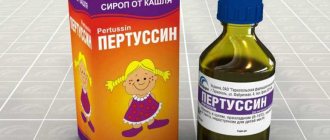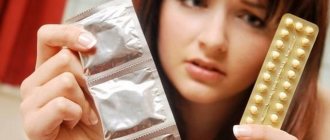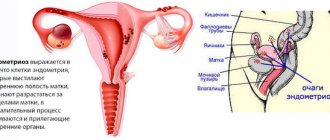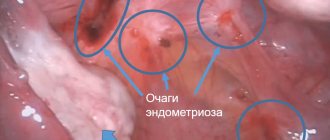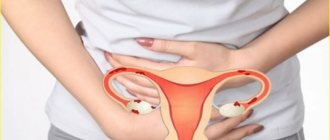General information about the disease
The growth of the endometrium provokes attacks of pain and enlargement of the affected organ.
Due to the growth of the inner uterine layer, monthly bleeding may intensify and lengthen, and secretions from the mammary glands appear. The exact causes of uterine endometriosis have not yet been established, so gynecologists classify it as a mysterious pathology, but there are a number of factors that can provoke this disease:
- The reproductive age of a woman, during which menstruation occurs. Menstruation, along with endometrial cells, can be partially thrown into the abdominal cavity;
- hormonal disorders that cause an increase in the concentration of follicle-stimulating and luteinizing hormones in combination with decreased progesterone;
- decreased protective functions of the body. In a healthy female body, endometrial cells outside the uterine cavity die, and with weakened immunity, the rate of their growth when they enter other organs only increases;
- genetic predisposition;
- surgical procedures, including abortion, cesarean section, diathermocoagulation of the cervix.
In later stages of the disease, the following symptoms may occur:
- pain in the pelvis with a feeling of fullness and heaviness in the lower abdomen. The pain can be clear and felt in a specific place or diffuse and felt more strongly before menstruation;
- in the first three days of menstruation, very severe pain is felt in the lower abdomen;
- menstruation comes more abundantly and lasts longer;
- pain during sexual intercourse;
- pain during the process of defecation and urination;
- scanty reddish or brown discharge before or after menstruation.
In some cases, the patient experiences nausea, including vomiting, fainting and general malaise. Your periods take longer and are more intense. Stopping bleeding is quite difficult, which leads to anemia. The situation is aggravated by an imbalance of sex hormones, due to which iron deficiency anemia only progresses.
https://youtu.be/of5fJcBDmfk
Hormonal drugs
The main goals of drug treatment for endometriosis are:
- suppression of ovarian functionality;
- inhibition of ovulatory processes;
- hypoestrogen induction;
- elimination of pathological foci of the disease.
Treatment with hormonal drugs is used quite widely due to the high effectiveness of this group of drugs and extremely low risks.
The following drugs are prescribed for the treatment of endometriosis:
- antiprogestins – Danazol , Mifepristone . These drugs suppress the synthesis of gonadotropin, which leads to drug-induced amenorrhea:
- GnRH agoists – Buserelin , Goserelin . These drugs affect the pituitary gland and hypothalamus, causing suppression of the secretion of pathological foci, which leads to atrophic phenomena in them;
- hormonal contraceptives - Zhanine , Yarina , Diane-35 , Klaira ;
- gestagens, for example Duphaston , are a hormonal drug whose action is aimed at regulating progesterone deficiency. Duphaston normalizes the functionality of the woman’s genital organs.
IMPORTANT!
Hormonal drugs for uterine endometriosis are recommended to be taken for a limited amount of time, this is due to the fact that this group of drugs has a large number of side effects. Therefore, independent and uncontrolled use of hormones is unacceptable.
Contraindications for hormone therapy
There are certain contraindications to treatment with hormones. Among the main ones are the following:
- allergy to the components of the selected drug;
- increased risk of thromboembolism;
- uterine fibroids or ovarian cysts requiring immediate surgical intervention;
- precancerous condition of the cervix or dysplasia;
- liver diseases;
- disorders of the hematopoietic system;
- failures of metabolic processes;
- kidney diseases requiring long-term therapy;
- disruption of the functional activity of the endocrine system;
- arterial hypertension;
- oncology.
If there is at least one contraindication, the effect on the body is achieved using non-hormonal treatment methods. The doctor carefully examines the medical history and conducts a number of additional studies. Only after this does non-hormonal treatment of endometriosis begin.
Non-hormonal treatment and traditional methods of getting rid of endometriosis
Treatment of the disease requires an integrated approach. And the earlier a woman consults a doctor, the higher the chance of success of the selected conservative treatment regimen.
If left untreated, a woman will develop new lesions during each period. Later, cystic formations appear, healthy tissues are replaced by scar tissue, which leads to the development of adhesive disease. The result is a violation of the patency of the fallopian tubes and infertility.
Pathology therapy is carried out in several directions. This is medical, surgical practice and a combination of these methods.
Treatment of endometriosis is carried out through a course of hormonal medications. Includes:
- oral contraceptives;
- gonadotropin-releasing hormone antagonists;
- progesterone and its analogues;
- drugs that block the production of follicle-stimulating hormone.
Combined OCs from the group of estrogen-progestogen agents are prescribed, in particular, “Zhanin” and “Yarina”. Helps in eliminating heavy, painful menstruation. Duration of treatment – up to 9 months.
"Utrozhetan" and "Duphaston" belong to the drugs from the group of gestagens. Prescribed for 6 months at any stage of the disease.
Treatment may be accompanied by the development of depressive states, the appearance of unscheduled bleeding, and soreness of the mammary glands.
Danazol
Danazol belongs to the group of antigonadotropic drugs. Designed to suppress the production of follicle-stimulating hormone.
Duration of treatment is 6–8 months. High levels of androgens and hirsutism are contraindications for use. During treatment, hair growth may increase and the activity of the sebaceous and sweat glands may increase.
"Buserelin" and "Goserelin" belong to the GnRH agonists. Used to suppress the menstrual cycle. They are effective, reduce the frequency of relapses, and eliminate pathological symptoms. Not prescribed for young women.
The fight against the disease comes down to suppressing the development of pathology by restoring the balance of hormones in the woman’s body. With the help of drug therapy, the process of estrogen production is partially suppressed. Due to this, it is possible to restore the normal menstrual cycle. Typically, drugs that have virtually no side effects and are well tolerated by patients are used to treat endometriosis.
This medication is often prescribed by specialists for the treatment of diseases of the reproductive system in women. Its action is aimed at increasing the tone of the myometrium, as well as its contractile activity. Mifepristone suppresses the production of progesterone and is involved in the process of fertilization. The medication is prescribed not only for the treatment of endometriosis, but also for terminating intrauterine pregnancy in the earliest stages, as well as for inducing labor.
- The presence of diseases of the digestive system (acute stomach and intestinal ulcers, gastritis, pancreatitis, bile stagnation, etc.).
- Problems with kidney function;
- Reduced hemoglobin level;
- Individual sensitivity to any component included in the medication.
It is contraindicated to take the medication for women who have inflammation of the ovaries and their appendages. You should not be treated with mifepristone for uterine fibroids. It is strictly forbidden for people suffering from alcohol or drug addiction to take the drug. The medicine can cause serious harm to women over 35 who smoke.
The medication is available in tablet form. The dosage is prescribed by a specialist for each patient individually based on her clinical picture. If any side effects occur, you should consult your doctor about its further use. When taking the medicine, you may experience unpleasant sensations - headache, abdominal discomfort, nausea and others.
Goserelin
A hormonal drug that is used for various types of oncology, as well as for the treatment of endometriosis of any degree. In most cases, it is prescribed to hormone-dependent patients. Goserelin is taken under strict medical supervision. The drug affects the production of testosterone. Self-medication is dangerous due to complications of the disease.
- Nausea and vomiting. The medication may suppress the production of certain enzymes, which affects the digestion process. In some cases, patients lose their appetite.
- Migraines and dizziness. Typically, these symptoms are observed in active women who take this drug for a long period of time.
- Allergic reactions. If there is individual sensitivity to the components of the drug, the patient may experience skin rashes throughout the body.
Goserelin should be taken in combination with other medications when treating endometriosis. Therapy is determined by the doctor based on the woman’s diagnosis and her general health.
It is not recommended to take this medication for pregnant women. In private cases, women are prescribed the drug, but they are first advised that such treatment is dangerous for the fetus.
During pregnancy, Goserelin can cause miscarriage. Also, you should not take the drug during lactation. During treatment, the woman should stop breastfeeding, and then return to it. Drug therapy is contraindicated for girls under 15 years of age. Goserelin helps cure endometriosis in a relatively short period of time.
This medication is often prescribed to prevent pregnancy. That is, it is used as a means of contraception. But it is also used in the treatment of endometriosis. Janine is a combined hormonal drug. It even helps get rid of chronic diseases of the reproductive system in women. It is prescribed in cases where the disease requires long-term treatment (from 2 to 3 months).
- Problems in the functioning of the cardiovascular system and blood circulation (it is especially dangerous to take medication in case of thrombosis and conditions preceding them);
- Dysfunction of the digestive system (liver cancer, cirrhosis, pancreatitis, ulcer);
- Metabolic problems (diabetes mellitus);
- Oncology of the reproductive system;
- Pregnancy, breastfeeding period
Taking the drug for alcohol or drug addiction can cause death in the patient. Women who smoke, are overweight, or have problems with the heart (have recently experienced a myocardial infarction) should take the medication with caution.
Vomiting, diarrhea or constipation may occur when taking Janine. In this case, the patient may experience nausea, an unpleasant taste in the mouth, and abdominal pain. If these symptoms occur, you should seek help from a specialist.
You should not ignore unpleasant sensations, as this is fraught with negative consequences - the development of ailments of the digestive, nervous, and cardiovascular systems.
Usually, folk remedies help get rid of the disease when it is at the initial stage of development.
Infusions and decoctions of medicinal plants are recommended to be taken in combination to establish normal functioning of the body as a whole.
Collection No. 1
To prepare a medicinal folk remedy, equal parts of nettle, shepherd's purse, calamus, bloodroot and serpentine roots are used. All ingredients are placed in one container, poured with boiling water, and allowed to brew. Taking this remedy helps:
- Establish normal metabolism. Herbal infusion also affects the production of hormones.
- Improve general condition. A folk remedy relieves pain and spasms. The feeling of fatigue and irritability disappears.
- Normalize sleep. Insomnia and nightmares stop bothering me. Sleep becomes deep, long, and restful.
Treatment with this folk remedy usually lasts a month. The duration of taking the infusion is determined by the doctor individually for each patient. It is not recommended to drink the infusion in the following cases:
- For severe diseases of the gastrointestinal tract (cancer, liver failure, etc.).
- For mental disorders (schizophrenia, delirium).
You should not take the product if you are pregnant or breastfeeding. It is also not recommended to drink the infusion for girls who have not yet had their first period when treating diseases of the reproductive system.
To prepare a folk remedy, you need to take dry celandine, kirkazona grass, and currant leaves in equal proportions. Pour boiling water over all this and let it brew for about an hour. Useful properties of this product:
- Improves blood circulation (prevents the formation of blood clots);
- Tones and soothes (helps quickly remove waste and toxins from the body);
- Strengthens the immune system (protects the body from possible infection by airborne viruses and bacteria);
- Restores vital energy (you feel a surge of strength and vigor).
Do not get carried away with taking this infusion. The dosage should also be agreed with your doctor. The product also helps get rid of headaches and increase hemoglobin levels.
Additional measures
Every woman, when treating and preventing diseases of the reproductive system, must follow the rules of a healthy lifestyle. To quickly get rid of the disease, you should:
- Quit bad habits. Smoking, alcohol, and drugs contribute to the development of the disease and also block the effects of medications and herbal infusions.
- Eat rationally. It is worth giving up fast food, fried, smoked foods, and canned food. You should monitor the amount of calories consumed per day (follow the norm).
- Avoid stressful situations. It is necessary to limit yourself from conflicts, scandals, showdowns and other unpleasant moments.
General recommendations for endometriosis
Endometrial degeneration is a poorly understood and complex disease. It brings pain, discomfort and complete inconvenience into the lives of girls and women. To improve the quality of life and reduce the manifestation of negative symptoms, you need to follow the recommendations of specialists:
- Nutrition has a positive effect on solving this problem. Therefore, you need to remove foods that cause inflammation: dairy products, gluten. Avoid refined sugar and coffee. chemically treated oils. Consult your doctor to create a personalized, anti-inflammatory diet.
- Keep your intestines clean.
- Do not give up regular physical activity, spend more time in the fresh air (reduces estrogen levels).
- Stop using tampons (leads to improper outflow of blood from the fallopian tube).
- Treat yourself with folk remedies whenever possible.
- Take antioxidants: vitamins C and E.
Endometriosis is provoked by operations (abortion, cauterization of cervical erosion, cesarean section, installation of a spiral, etc.). On the days of menstruation, you need to follow a gentle regime. Do not overuse solariums or take sunbathing.
Can endometriosis be cured with medications?
It is practically impossible to cure the disease completely, but we will look at what methods can be used to alleviate the condition in a given case. Drug treatment of endometriosis is prescribed in the following situations:
- infertility has been established;
- adenomyosis;
- the woman is of reproductive age;
- the pathology was discovered accidentally during a gynecological examination and occurs without symptoms.
Radical surgery is most often used in cases where there is a high risk of malignancy in the affected areas.
Next, we will consider in more detail what medications can treat endometriosis.
Surgery
The surgical method is considered to be the most effective in the fight against the disease. Through surgery, it is possible to completely remove the pathology. The most commonly used minimally invasive method is laparoscopy.
Laparoscopy
The laparoscopy procedure for endometriosis allows you to eliminate lesions without large-scale surgery. It is carried out by introducing a special device into the peritoneal cavity and determining the size of the damage. Endometriosis can affect not only the uterus, but also other organs. It is extremely important to identify such changes and correct them during surgery.
Laser therapy using laparoscopy has a number of advantages:
- possibility of diagnostics and treatment;
- organs are damaged only to a minor extent;
- there is no negative impact on reproductive function;
- During the operation, adhesions are removed, which has a positive effect on fertility.
Physiotherapy in the early stages
The method is contraindicated in the following cases:
- the presence of endometrioid cysts on the appendages;
- severe form of the disease;
- taking psychotropic substances to eliminate neurological and mental disorders.
In these cases, you need to look for another option on how to cure endometriosis without hormones.
The following procedures can be used during therapy:
- iodine electrophoresis;
- magnetic therapy;
- ultraviolet radiation and magnetic laser therapy.
Balneotherapy
The method involves combating pathology by taking radon and iodine-bromine baths, which are supplemented by microenemas and vaginal irrigation with radon water.
Radon baths have the following effects on the body:
- pain suppression;
- normalization of gonadotropin levels;
- sedative effect;
- stimulation of progesterone production;
- decrease in estrogen concentration.
The achieved effect can be maintained for the whole six months. Iodine-bromine baths and vaginal irrigation help achieve the following results:
- the sensitivity threshold increases;
- the functional activity of the thyroid gland is normalized;
- blood pressure decreases;
- estrogen synthesis is suppressed;
- inflammatory processes are eliminated.
The computer reflexology method is used for various forms of pathology. The procedure is designed to restore neuroendocrine connections and regulate immune processes. This tactic gives the patient the opportunity to restore reproductive function and normalize hormonal levels.
The manipulation is carried out by exposing weak direct current discharges to areas connecting the nervous and autonomic systems with the brain. Additionally, medications are prescribed.
This treatment method helps:
- stabilization of the nervous system;
- activation of the body's protective functions;
- normalization of hormonal levels;
- restoration of the reproductive system;
- cure infertility.
Other conservative treatments for endometriosis
In addition to taking medications, there are other methods of conservative treatment of the disease. To improve the condition, modern computer and physiotherapeutic techniques are used.
Computer reflexology
It helps to influence points of the body using mild electrical discharges. As a result, the functioning of the autonomic nervous system is normalized, hormonal levels are regulated, and immunity is improved. After therapy with this method, the menstrual cycle is restored and the mental state improves. Cases are described when, after computer reflexology, a woman, after many unsuccessful attempts, was able to become pregnant.
Physiotherapy
In the acute period, physiotherapy is not used - it is prescribed after relief of the main symptoms. Procedures are contraindicated in advanced stages of endometriosis and in the formation of cysts in the ovaries.
For this pathology, the use of low-frequency currents, magnetic, laser and balneotherapy is indicated. It is useful to take radon or iodine-bromine baths, douching and microenemas.
Procedures that increase the release of estrogen are prohibited. These include:
- massage in the lumbar and sacrum areas;
- mud;
- paraffin applications;
- baths with hydrogen sulfide or turpentine.
Folk remedies
As folk remedies, you can use boron uterus (infusion and decoction), honey tampons, and anti-inflammatory preparations. Celandine helps well, which is diluted with water in a decoction and used for baths and douching. An aqueous or alcoholic infusion of propolis is used in combination.
About alternative therapy for endometriosis
Many experts consider various non-traditional methods of treating endometriosis to be ineffective, preferring surgical and hormonal treatment methods. Reviews from women who have tried this therapy are different: some write about improvement, while some patients indicate a lack of results.
https://youtu.be/6Ds_gqJZGws
What candles can be used
If a large number of analgesics are contraindicated for the patient, then suppositories with an analgesic effect can be prescribed for endometriosis. The most effective non-steroidal anti-inflammatory suppositories for this disease are Diclofenac, Indomethacin. They relieve pain quickly and for a long time.
Not every remedy in the form of suppositories is administered intravaginally for endometriosis; there are medications that are prescribed for rectal use:
- Flamax based on ketoprofen. Apply once a week;
- Diclofenac. Use 1 suppository every day;
- Voltaren. A strong painkiller that is used 2 times a day;
- Movalis. Use a candle at night, no more than a week;
- Indomethacin. Use every day at night.
The dosage and combination of drugs in the treatment of endometriosis can be selected exclusively by the attending physician.
Herbal medicine for endometriosis
Folk remedies will not only cure the underlying disease. But it will also saturate the body with useful vitamins and microelements. Normalizes a woman's hormonal levels. Eliminate painful sensations, relieve irritability and anxiety. Various herbs are used to treat endometriosis.
The herb is best brewed in a thermos, like tea.
They make decoctions, infusions, and douche. The hog queen has proven itself well. For endometriosis, you need to drink decoctions daily according to the following recipes:
- 1 tbsp. l. herbs pour 1 tbsp. boiling water, hold in a water bath for 15 minutes. Cool slightly, take 1 dess. l. before eating. A similar tincture can be made with vodka.
- 50 gr. herbs pour 0.5 ml of vodka. Leave for 3 weeks in a dark place. Take 20-25 drops before each meal.
At home, you can treat yourself with herbs - red brush. True, the treatment will be quite long, up to 2-3 months. Every morning you need 1 tbsp. l. herbs pour 300 ml of boiling water. Take 100 ml. before meals.
You can also make an alcohol tincture at home (0.5 liters of vodka, 3 tablespoons of herbs), leave for a month. Drink 3 times a day, 20 drops. Then a break for a month, if necessary, repeat the treatment. Douching brings very good results. Dilute the alcohol tincture with water: 1 tsp. for 500 ml of warm water.





